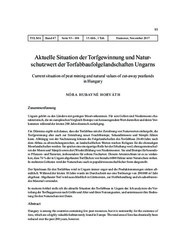Aktuelle Situation der Torfgewinnung und Naturschutzwert der Torfabbaufolgelandschaften Ungarns
Horváth, Nóra Hubayné
Horváth, Nóra Hubayné, 2017: Aktuelle Situation der Torfgewinnung und Naturschutzwert der Torfabbaufolgelandschaften Ungarns. In: TELMA - Berichte der Deutschen Gesellschaft für Moor- und Torfkunde, Band 42, 2017: 93 - 108, DOI: 10.23689/fidgeo-3879.
 |
Dokument öffnen: |
Hungary is among the countries containing few peat resources, but it is noteworthy for the existence of
fens, which are a highly valuable habitat rarely found in Europe. The total area of fens has drastically been
reduced over the past 200 years, however.
A dilemma exists, because on one hand, peat extraction destroys natural resources, while on the other
hand it simultaneously creates newly-formed wetland habitats, secondary mires and swamps. Twenty-to-
forty years after mining, these once cut-away peatlands turn into rich, diverse refuge areas, which play a
unique role in preserving the biomes of fens and swamps, and in peat re-accumulation. They serve as a
habitat for rare plant species, as well as birds and fishes. Due to the unique role of these areas, 76 percent
of the approximately 6000 hectares of extracted peatlands in Hungary is protected natural area. Many of
these lands serve as demonstration areas for our natural heritage.
In spite of these benefits, the rate of peat mining has been declining. During the past decade, the extracted
volumes were only about 200 000 cubic meters per year. Nowadays peat is only used in horticulture, in
balneology, and as a filter and adsorbent material.
This article summarizes the current situation of peat mining in Hungary, while it also analyzes the distri-
bution by size and age of peat mines, and demonstrates the current use of cut-away peat lands. It also pro-
vides data to show the significance of cut-away peat lands in nature conservation.

